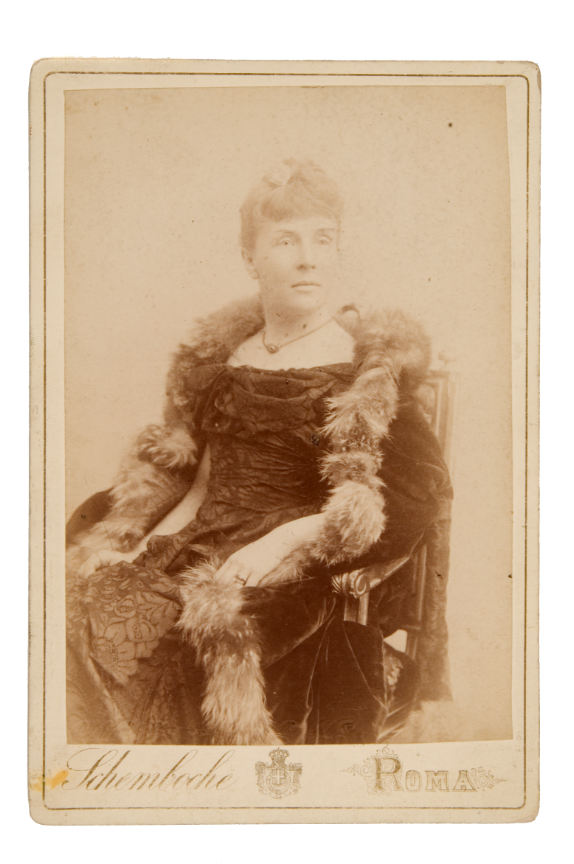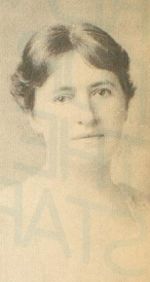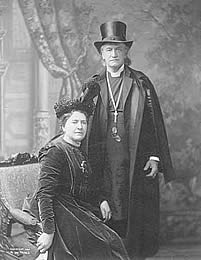Rose Cleveland and Evangeline Marrs Simpson Whipple: 1889-1918
The President's Sister and the Bishop's Wife
by Jonathan Ned Katz
Rose and Evangeline
In 2008, as a new president is elected, OutHistory.org is pleased to present the story of an earlier White House resident and her lover, an unfamiliar bit of lesbian American history.[1]
As playful provocation, I cannot resist subtitling this story in the suggestive mode of Victorian pornography. But that subtitle misleads; it defines Rose Elizabeth Cleveland and Evangeline Marrs Simpson Whipple by the men in their lives. And despite Rose's sibling tie to a president and Evangeline's marriage to a bishop, this is a story of two women's romance with each other.
In Florida, during the winter of 1889-1890, Rose Cleveland and Evangeline Simpson fell madly in love. And when the winter season ended, Evangeline urged Rose on to another rendezvous: "Oh, darling, come to me this night--my Clevy, my Viking, my Everything--Come!"
Who was this impassioned Evangeline, this ardent Rose?
Rose, at 44, was a well-off spinster (as they said), teacher, and successful lecturer on women's rights who had edited a Chicago literary magazine, Literary Life.[2] Cleveland had also published George Eliot's Poetry, and Other Studies (1885) and a novel, The Long Run (1886), described as "the long winding of romance between a moderately Romantic man and the society lady who each summer visits his small town."[3] The same year she published You and I: Or Moral, Intellectual and Social Culture.[4] And with the feminist leader Frances Willard, Cleveland published How to Win: A Book for Girls (1887).[5] In 1888, the year before Rose Cleveland met Evangeline Marrs Simpson, Cleveland wrote an introduction to book titled Social Mirror: A Complete Treatise on the Laws, Rules and Usages that Govern our Most Refined Homes and Social Circles.[6]
As Grover Cleveland's ultrarespectable sister, Rose had helped her brother survive the scandal of fathering a child out of wedlock and then win his first presidential term (1885-1889). Rose had stood by Grover as First Lady during his inauguration and his two initial bachelor years in the White House.
Evangeline was a wealthy widow of 30, well educated and well traveled, and fluent in several languages. The fortune of her businessman husband, Michael Simpson, had supplemented her own when he disappeared at sea.
Rose to Evangeline, April 1890
Soon after Rose and Evangeline's fervid Florida inaugural, in April 1890 on a boat in the Gulf of Mexico, Rose wrote to Evangeline, suggesting that they meet in New York City--though she'd then be forced to stay at Grover's. She added, hopefully, "But if you liked, I could spend most of the time at your hotel--in your room.
"Ah, how I love you!" Rose exclaimed. Evangeline's letters made her "heavy with emotion." Rose proclaimed, "Ah, Eve, Eve . . . you are mine by every sign in Earth and Heaven--by every sign in soul and spirit and body."
"Oh, Eve, I tremble at the thought of you," Rose declared, closing, "Sweet, Sweet, I dare not think of your arms." The two did get together again, apparently in that New York hotel room.
Rose from Utica, NY
The intimacy grew. Rose wrote from her home near Utica, N.Y., "I love you, love you beyond belief--you are all the world to me."
Rose viewed Eve's picture, "the look of it all making me wild." During the night, said Rose, "I . . . tried to feel your hand--but it is no use, Eve. I am sure of you, but I do not see your delightful face--or feel your enfolding arms-- and lose all else in the shelter and happiness of that haven."
"My Eve," said Rose, and refered to her friend's "long rapturous embraces--when her sweet life-breath and her warm enfolding arms appease my hunger and quiet my breast--and carry us both in one to the summit of joy, the end of search, the goal of love!" (This is one of the most explicit, unambiguous references in the nineteenth-century to two women's mutual orgasm with each other.)
Rose called Eve "the woman who is my world--my Earth--and God forgive me--my Heaven!" She compared Eve to Cleopatra and herself to Antony: "Ah, my Cleopatra . . . looks a very dangerous Queen--but I will . . . crush those Antony-seeking lips." She ended this letter with a tease: "How much kissing can Cleopatra stand?"
Life Together, Life Apart
For a year and a half, Rose and Evangeline lived together. But by 1892, Eve, though still asserting her love for Rose, had apparently decided to seek a socially sanctioned relation with a man. Rose said she would not stand in Eve's way but acknowledged her own "pain" and "hurt" and began to distance herself emotionally from Eve.
In the 1892 election, Grover Cleveland was returned to the presidency for a second term (after Benjamin Harrison's tenure). In 1893, Rose wrote to Eve on White House stationery. Though still having trouble separating from her friend, Rose sent Eve "my best blessing--whatever you do."
Evangeline and Henry Benjamin Whipple
"how much we need . . . all the love we can get"
In 1895, Rose wrote to congratulate Eve's fiance, the widower Henry Benjamin Whipple, the Episcopal bishop of Minnesota, on the success of his courtship. She added poignantly, "Ah, how much we need, all of us, all the love we can get." A year later, the 36-year-old Evangeline became the second wife of the 74~year-old bishop.
When Bishop Whipple died in 1901, Evangeline waited the required year, then abruptly left for Europe and never returned to the bishop's Minnesota.
Together Again
By 1905 Rose and Eve were writing to each other again, and by 1908-1909 they were making travel plans. In 1910 Rose assured the Cunard Line that she and Eve would happily share a cabin.
The two women lived together in Italy for eight years until Rose dieed of fever in the 1918 epidemic. Evangeline died 12 years later, having directed her executors to bury her in Italy beside Rose and another woman friend.
History of the Evidence: A Mole in Minnesota
We know of the romance between Rose Cleveland and Evangeline Marrs Simpson Whipple only because of an anonymous mole, a sleuth in the archives, who in the late 1970s, sent a tip to Barbara Gittings, coordinator of the Gay Task Force of the American Library Association, who passed the tip along to Jonathan Ned Katz.
Mole informed us that the Minnesota Historical Society held "a sealed box (no. 10)" of Rose Clevland's letters to Evangeline Whipple, "revealing that a lesbian relationship existed between the two women." The public "catalog for this collection . . . lists only nine boxes."
In 1978, after several tactfully worded letters to the Minnesota Historical Society, Katz was told that an unlisted box of Rose Cleveland's correspodnence did indeed exist and had previsous been closed to reseachers until 1980. But "due to current scholarly interest" this restriction had been removed.
Katz ordered copies of the letters. But then, because Rose Cleveland's handwriting turned out to be so difficult to read and because of other priorities, he gave up the idea of transcribing and publishing the letters. He did, however, alert a group of lesbian and gay historians to their existence.
By a combination of good luck and good networking, one of these historians, Bert Hansen, knew a graduate student who had attended St. Mary's Hall, a Minnesota school founded by Bishop Whipple. That student, Paula Petrik, well recalled the imposing painting of Evangeline Whipple that hung in the school's dining room. Hearing of the letters in box 10, Petrik researched the lives and loves of Rose and Ebangeline for a term paper.
Katz is deeply indebted to Petrik, who in January 1989 was a professor of history at the Univesiy of Maine at Orono, and whose unpublished paper enabled him to briefly reconstruct Rose and Evangeline's relationship for an essay in The Advocate. Petrik's research also allowed John D'Emilio and Estelle Freedman to include a paragraph on Rose and Evamgeline, and few lines of Cleveland's letters, in Intimate Matters, their 1988 book on American sexual history.
Thanks to the mole in the archive, eleven years after the secret box was opened to the public, this almost suppressed episode of lesbian American history had finally come to light.
But most of all, we have to thank the courage of Evangeline Marrs Simpson Whipple in preserving Rose Cleveland's love letters to her, so that we--in a very different time and place--can read about, know, and contemplate these two women's intimate and sexual relationship.
Photograph: Rose Elizabeth Cleveland. Rome, Italy, 1880s.

Notes
- ↑ This essay first appeared as "Katz on History: The President's Sister and the Bishop's Wife: An Advocate Inauguartion Special," The Advocate, January 31, 1989, pages 34-35, on the occasion of a presidential inaugural.
- ↑ On Literary Life see Herbert Easton Fleming, Magazines of a Market-Metropolis (pub data?), pages 523-524. Cleveland apparently edited the magazine in its earliest three months from her home in New York. Research Request: It would be interesting to know if anything appears in those issues that relate to intimate relationships between women.
- ↑ Rose Elizabeth Cleveland, The Long Run (Detroit, MI: F.B. Dickerson & Co., 1886), 146 pages. Accessed November 4, 2008, 3:56 pm from: http://www.gsbbooks.com/cgi-bin/gsb455/12216.
- ↑ Rose Elizabeth Cleveland, You and I: Or Moral, Intellectual and Social Culture (Detroit, MI: F.B. Dickerson, 1886).
- ↑ Frances Willard and Rose Elizabeth Cleveland, How to Win: A Book for Girls (Place of pub? Publisher? 1887) Lillian Faderman discusses Frances Willard's romantic cohabitation with Anna Gordon, a fellow activist, and subsequently with Kate Jackson, a locomotive heiress; see To Believe in Women: What Lesbians Have Done for America - A History (NY: Houghton Mifflin Books, 2000.
- Re Cleveland's other work, an article. "The Role of First Lady: Martha Washington to Laura Bush," in Presidents: A Reference History (2002) by Betty Boyd Caroli, says: "Rose Cleveland took leave from a teaching career in 1885 to assist her bachelor brother, Grover Cleveland, at the White House. She did not thrive on the social role, much preferring to concentrate on her literary interests, and she admitted that she found receiving lines so boring that she conjugated difficult Greek verbs to keep alert. When she published George Eliot's Poetry, and Other Studies in 1885, newspapers congratulated her on her first book; but generally preferred to report on her hostessing. After Grover Cleveland's marriage in June 1886, Rose Cleveland resumed her own career." Accessed on November 4, 2008, 2:35 pm, from: http://findarticles.com/p/articles/mi_gx5225/is_2002/ai_n19143675/pg_3. For sources on Cleveland's life see: First Ladies By Betty Boyd Caroli (NY: Oxford University Press, 1995), pages 102-03 and notes 89-92 on pages 320-21. Research Request: It would be interesting to know what Cleveland's books might reveal about her close relationships with women.
- Also see: The Soliloquies of St. Augustine, translated into English by Rose Elizabeth Cleveland. With Notes and Introduction by the Translator (Boston: Little, Brown, and Co., 1910). Text online November 4, 2008, 3:38 pm at: http://oll.libertyfund.org/index.php?option=com_staticxt&staticfile=show.php%3Ftitle=1153&Itemid=28
- Rose Cleveland appears in a fascinating game: "Grover Cleveland," produced by Bully Pulpit Games and Amusements (Chapel Hill, NC, copyright 1907); see: http://www.google.com/search?hl=en&q=%22Rose+Cleveland%22+%22Library+of+Congress%22&start=10&sa=N.
- ↑ St. Louis, Missouri: L.W. Dickerson, 1888).
Bibliography
D'Emilio, John, and Estelle Freedman. Intimate Matters: A History of Sexuality in the United States. <pub data to come>
Faderman, Lillian. Odd Girls and Twilight Lovers: A History of Lesbian Life in Twentieth-Century America, <pub data to come>, pages 32-33.
Freedman, Estelle. "The Historical Construction of Homosexuality," in Feminism, Sexuality, and Politics: Essays. <place of pub>: University of North Carolina Press, 2006, page 114.
Katz, Jonathan Ned. "Katz on History: The President's Sister and the Bishop's Wife: An Advocate Inauguartion Special," The Advocate, January 31, 1989, pages 34-35.
Millett, Nervina. "Rose Elizabeth Cleveland." CulturaGay.it. On Cleveland and Evangeline Whipple in Bagni di Lucca, Italy. 1993. Accessed November 3, 2008, 8:33 pm.
Petrik, Paula. "In the Open: Lesbianism at the Turn of the Century. Typed manuscript, unpublished, in the Lesbian Herstory Archives, Brooklyn, New York.
Wikipedia. Rose Cleveland.[1]. Accessed November 4, 2008, 11:14 am.
Copyright (c) 2008 by Jonathan Ned Katz. All rights reserved.


